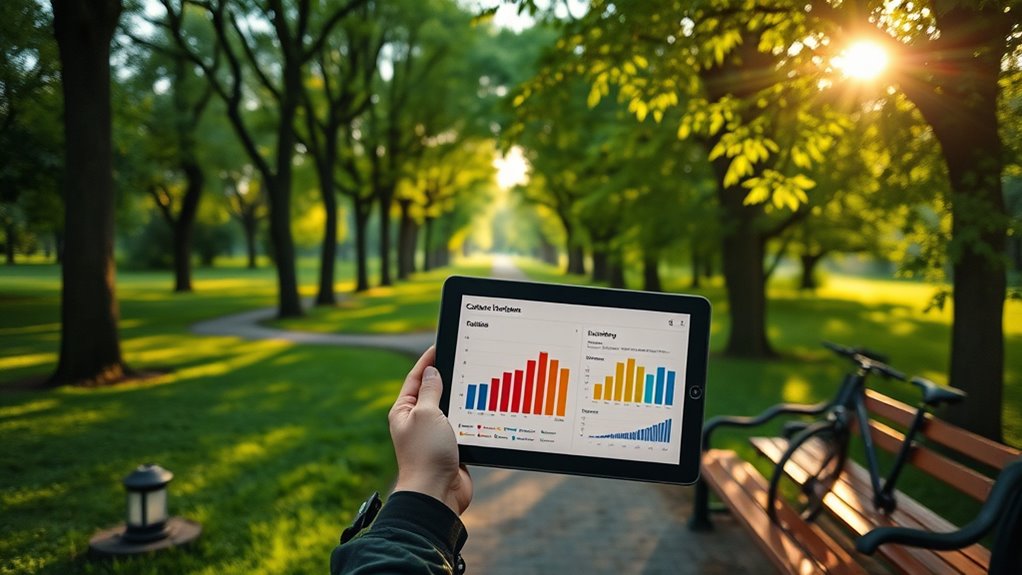To calculate your carbon footprint, use online tools that consider your energy use, transportation, and lifestyle habits by inputting data like utility bills and miles driven. To offset it, invest in renewable energy sources such as solar panels, switch to green energy providers, and adopt eco-friendly practices like walking or biking. Small changes can add up, and staying informed will help you discover more effective ways to reduce and offset your emissions.
Key Takeaways
- Use online carbon footprint calculators by inputting data on energy use, transportation, and lifestyle habits.
- Track emissions from activities like electricity consumption, travel miles, and device usage for accurate assessment.
- Reduce your footprint by switching to renewable energy, adopting sustainable transportation, and using energy-efficient appliances.
- Offset remaining emissions through carbon offset programs such as tree planting or renewable energy projects.
- Regularly monitor and update your data to measure progress and adjust strategies for ongoing carbon reduction.

Understanding your carbon footprint is a crucial step toward reducing your environmental impact. Your carbon footprint measures the total greenhouse gases you produce through everyday activities, from driving to energy use. To start, you need to gather information about how much energy you consume at home, your transportation habits, and your diet. Once you know where your emissions are coming from, you can begin to identify effective ways to cut back. One significant way to lower your footprint involves shifting to renewable energy sources for your electricity needs. By choosing providers that offer solar, wind, or other clean energy options, you reduce reliance on fossil fuels, which are the primary culprits behind greenhouse gas emissions. Installing solar panels on your roof can further decrease your carbon footprint by generating your own renewable energy and reducing dependence on grid power.
Reducing your carbon footprint starts with switching to renewable energy sources like solar and wind.
Transportation is another major contributor to your carbon footprint, and opting for sustainable transportation options can make a noticeable difference. Instead of driving a gasoline-powered vehicle, consider switching to electric vehicles or hybrid cars that produce fewer emissions. If you’re able, walking, biking, or using public transportation can eliminate your transportation-related emissions altogether. Carpooling with colleagues or friends also cuts down on individual emissions while providing the added benefit of social interaction. Implementing sustainable transportation habits not only helps the environment but can also lead to cost savings and a healthier lifestyle. Additionally, adopting efficient vehicle choices can significantly reduce your transportation emissions over time. Incorporating emissions tracking tools into your routine can help you monitor progress and stay motivated to reduce your footprint. Moreover, staying informed about emerging sustainable transportation options can help you adopt innovative solutions as they become available.
Calculating your carbon footprint involves using online calculators that take into account your energy consumption, transportation habits, and lifestyle choices. These tools often ask for details like your monthly electricity bill, miles driven annually, and types of fuel used. Once you input your data, you’ll receive an estimate of your overall emissions. This awareness empowers you to make targeted changes to reduce your impact. Additionally, understanding how high-performance projectors contribute to energy consumption can help you select more efficient devices for your home entertainment systems. Remember, small adjustments—like switching to renewable energy or adopting sustainable transportation—can add up over time, leading to a substantial reduction in your overall carbon footprint. Engaging in community initiatives or supporting policies aimed at emission reductions can further amplify your efforts.
Frequently Asked Questions
How Often Should I Recalculate My Carbon Footprint?
You should recalculate your carbon footprint at least once a year to keep your carbon tracking accurate and up-to-date. Regular footprint monitoring helps you see how your actions impact the environment and identify areas for improvement. If your lifestyle changes substantially—like moving, traveling more, or adopting new habits—consider recalculating sooner. Staying consistent with footprint monitoring ensures you’re effectively managing your environmental impact over time.
What Are the Most Effective Offset Projects to Support?
You want to support the most effective offset projects, and renewable energy and reforestation projects are excellent choices. Renewable energy projects reduce reliance on fossil fuels, cutting emissions directly. Reforestation helps absorb existing carbon dioxide, restoring ecosystems. By investing in these projects, you actively contribute to lowering global emissions and fighting climate change. Supporting certified initiatives guarantees your efforts genuinely make an impact, making your offsetting both responsible and effective.
Can Individual Actions Significantly Reduce My Overall Footprint?
Your personal habits and community initiatives can considerably reduce your overall footprint. By making eco-friendly choices like conserving energy, reducing waste, and supporting local projects, you directly impact your carbon emissions. Participating in community initiatives amplifies your efforts, creating a larger positive effect. Small daily changes and collective action together make a meaningful difference in reducing your environmental impact, helping fight climate change more effectively.
How Do I Verify the Credibility of Offset Programs?
You should verify offset programs by checking for third-party certifications like Verra or Gold Standard, which guarantee credibility. Review transparency reports to see project details, emissions reductions, and funding practices. Ask for clear documentation and updates on project progress. This helps confirm your offset investments genuinely reduce your carbon footprint. Making informed choices ensures your efforts are effective and trustworthy, giving you confidence in your environmental impact.
What Are the Costs Associated With Offsetting My Carbon Emissions?
You’ll find that offset costs vary based on your emissions and chosen programs. Some initiatives cost as little as a few dollars per ton, while others can be higher. Keep in mind, a carbon tax might incentivize you to reduce emissions, but government incentives can help offset expenses. By exploring credible offset programs, you can balance costs and support sustainable projects without breaking the bank.
Conclusion
By understanding how to calculate and offset your carbon footprint, you’re not just making a choice—you’re wielding the power to change our future. Each small step, like planting trees or reducing travel, becomes a beacon of hope in a world crying out for help. Remember, your actions echo beyond today, shaping the planet for generations to come. Will you rise to the challenge and be the hero our Earth needs? The time to act is now.









